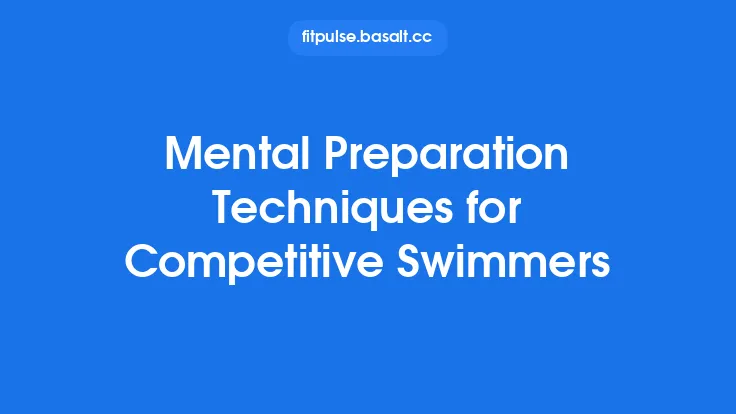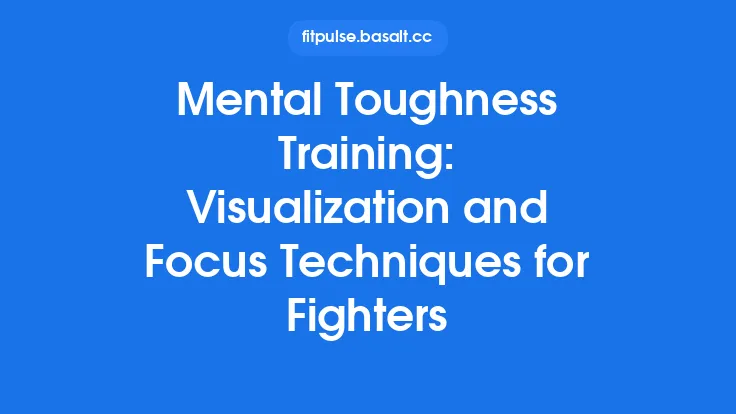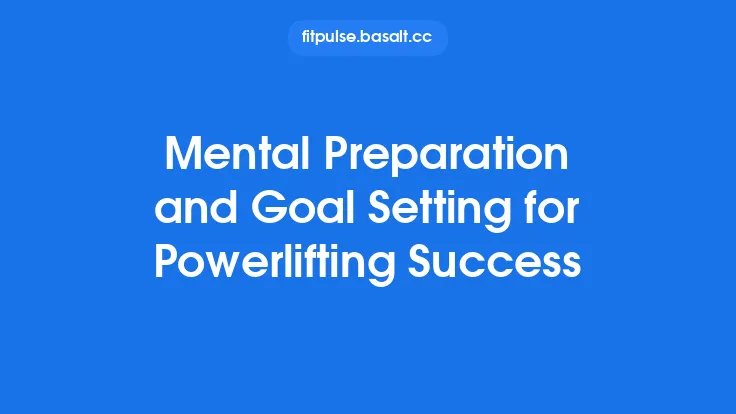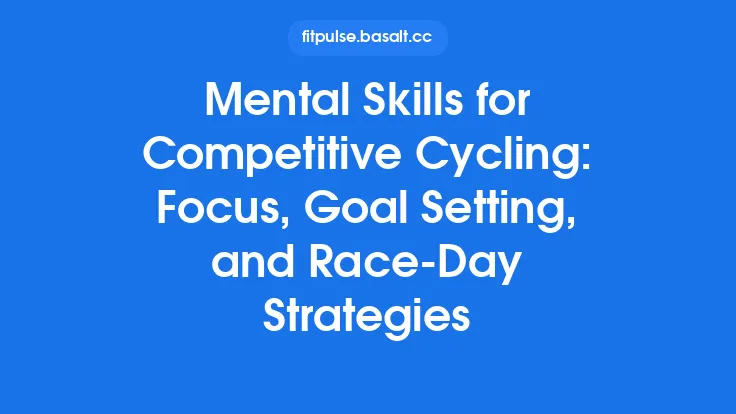Winter sports demand more than just physical prowess; the icy environment, high speeds, and split‑second decision‑making amplify the mental challenges athletes face. Whether you’re carving down a steep alpine run, navigating a slalom course, or powering through a cross‑country ski race, the mind can be the decisive factor between a podium finish and a missed gate. Below is a comprehensive guide to mental preparation techniques that can be applied year‑round to sharpen focus, boost confidence, and sustain performance under the unique pressures of competitive winter sports.
Understanding the Psychological Demands of Winter Sports
Winter athletes contend with a blend of physiological stressors (cold, altitude, equipment constraints) and psychological stressors (fear of injury, variable weather, high‑stakes competition). Recognizing these demands is the first step toward building a mental skill set that can adapt to changing conditions.
- Environmental Uncertainty – Snow quality, temperature, and wind can shift dramatically, requiring rapid tactical adjustments.
- High‑Speed Decision Making – In disciplines like downhill skiing or speed skating, athletes must process visual information and execute motor responses within fractions of a second.
- Performance Anxiety – The visibility of mistakes (e.g., a missed gate) can heighten self‑criticism and fear of failure.
By mapping these stressors onto a personal performance profile, athletes can target specific mental techniques that address their most pressing challenges.
Goal Setting and Planning
Clear, structured goals provide direction and motivation. Use the SMART framework (Specific, Measurable, Achievable, Relevant, Time‑bound) to create both long‑term aspirations (e.g., “Qualify for the World Cup circuit within two seasons”) and short‑term process goals (e.g., “Execute a consistent pre‑run breathing routine before every training session”).
Action Steps
- Write Goals Down – Physical act of writing reinforces commitment.
- Break Goals into Micro‑Tasks – For a long‑term goal, list weekly or daily actions that move you forward.
- Review Weekly – Assess progress, adjust tasks, and celebrate small wins to maintain momentum.
Goal setting also helps athletes shift focus from outcome‑based pressure (“I must win”) to controllable process elements (“I will maintain my rhythm on the left turn”).
Visualization and Mental Imagery
Imagery is a powerful tool for rehearsing technical skills, race strategies, and emotional responses without the physical wear and tear of on‑snow training.
- Structural Imagery – Visualize the exact sequence of movements (e.g., the feel of edging into a carve).
- Strategic Imagery – Picture the entire course, noting where you’ll accelerate, conserve energy, or adjust line.
- Emotional Imagery – Envision yourself staying calm and confident when faced with a sudden gust of wind or a near‑miss.
Technique
- Find a Quiet Space – Sit or lie down, close your eyes, and take three deep breaths to settle.
- Engage All Senses – Hear the crunch of snow, feel the cold air, sense the vibration of the board or skis.
- Rehearse in Real‑Time – Run the mental movie at the same speed you would physically perform.
- Add Variability – Occasionally imagine adverse conditions (e.g., icy patches) to build adaptability.
Regular imagery sessions (5–10 minutes, 3–4 times per week) have been shown to improve motor learning and confidence in athletes across sports.
Arousal Regulation and Breathing Techniques
Winter sports often trigger heightened arousal due to speed and risk. Managing this arousal is essential for optimal coordination and decision‑making.
Box Breathing (4‑4‑4‑4)
- Inhale through the nose for a count of 4.
- Hold the breath for a count of 4.
- Exhale slowly through the mouth for a count of 4.
- Hold again for 4 seconds before the next inhale.
Practicing this cycle before a run or race can lower heart rate, reduce muscle tension, and sharpen focus.
Progressive Muscle Relaxation (PMR)
Systematically tense and release muscle groups (starting from the feet and moving upward) to release residual tension that may have built up during warm‑ups or travel. PMR is especially useful after a high‑intensity training block when the body is primed for over‑activation.
Pre‑Performance Routines
Consistent routines create a sense of control and cue the brain to transition into a competitive state. A well‑crafted routine can include:
- Equipment Check – Verify bindings, wax, and boot fit.
- Physical Warm‑Up – Dynamic drills that mimic sport‑specific movements.
- Mental Cue – A short mantra (“Smooth and steady”) repeated silently.
- Breathing Reset – One or two cycles of box breathing.
The routine should be rehearsed during training so that on competition day it feels automatic, reducing decision fatigue and anxiety.
Self‑Talk and Cognitive Restructuring
The internal dialogue can either fuel confidence or sabotage performance.
- Positive Self‑Talk – Replace “I can’t handle this speed” with “I have trained for this speed; I trust my technique.”
- Process‑Focused Statements – Emphasize actions (“I will keep my weight centered”) rather than outcomes (“I must win”).
Cognitive restructuring involves identifying negative automatic thoughts, challenging their validity, and substituting them with balanced alternatives. Keeping a thought journal after each training session helps athletes become aware of recurring patterns and track progress.
Mindfulness and Concentration Training
Winter environments are full of distractions: wind, crowd noise, and visual clutter. Mindfulness cultivates present‑moment awareness, allowing athletes to stay anchored to the task at hand.
Focused Attention Meditation
- Sit comfortably, eyes closed.
- Choose a focal point (e.g., the sensation of breath at the nostrils).
- When thoughts arise, acknowledge them without judgment and gently return focus to the breath.
Practicing 10 minutes daily improves selective attention, which translates to better lane focus in speed skating or line selection in slalom skiing.
Cue‑Based Concentration Drills
During on‑snow drills, assign a simple auditory cue (e.g., a click from a metronome) and practice maintaining a specific technique (e.g., edge angle) in sync with the cue. This trains the brain to filter out extraneous stimuli and lock onto a single performance variable.
Managing Competitive Pressure and Anxiety
High‑stakes events can trigger performance anxiety, manifesting as muscle tightness, racing thoughts, or premature fatigue.
- The “3‑2‑1” Grounding Technique – Identify 3 things you see, 2 things you hear, and 1 thing you feel. This quickly shifts attention away from anxiety‑provoking thoughts.
- Pre‑Event “Worst‑Case Scenario” Planning – Write down the most feared outcome (e.g., a fall) and outline a concrete recovery plan. Knowing you have a plan reduces the emotional impact of the fear.
Incorporate these strategies into pre‑competition briefings to normalize anxiety and provide athletes with actionable coping tools.
Building Resilience and Coping with Setbacks
Winter athletes inevitably face setbacks: missed qualifications, equipment failures, or weather‑induced cancellations. Resilience training helps maintain motivation and bounce back faster.
- Reflective Debrief – After a setback, write a brief analysis: what went well, what can be improved, and one actionable step for the next session.
- Growth Mindset Reinforcement – Emphasize that abilities can be developed through effort and learning, rather than being fixed traits.
- Social Support Networks – Regular check‑ins with coaches, teammates, or sports psychologists provide perspective and emotional buffering.
Resilience is not a one‑off skill; it requires ongoing practice and reinforcement.
Team Dynamics and Communication
Even in individual winter disciplines, athletes often rely on coaches, technicians, and support staff. Clear communication reduces uncertainty and builds confidence.
- Pre‑Run Briefings – Discuss course conditions, tactical adjustments, and mental cues.
- Feedback Loops – Use “I” statements (“I felt my balance shift on the left turn”) rather than blame (“The snow was too hard”).
- Shared Mental Scripts – Develop a common language for mental strategies (e.g., “reset” to indicate a quick mental reset after a mistake).
Strong team communication creates a unified mental environment that supports individual performance.
Sleep and Mental Recovery
Cognitive function, mood regulation, and motor learning are all highly dependent on quality sleep. Winter athletes often travel across time zones and train in cold environments that can disrupt sleep patterns.
- Sleep Hygiene Checklist
- Keep a consistent bedtime and wake‑time, even on travel days.
- Limit screen exposure 30 minutes before bed; use blue‑light filters if needed.
- Maintain a cool, dark sleeping environment (≈ 16‑18 °C).
- Power Naps – 20‑minute naps in the early afternoon can restore alertness without interfering with nighttime sleep.
Prioritizing sleep is a low‑cost, high‑impact strategy for mental sharpness.
Integrating Mental Skills into Training Programs
To avoid treating mental preparation as an afterthought, embed psychological drills within physical sessions.
- Combined Imagery + Physical Rehearsal – Before a technical drill, spend 2 minutes visualizing the movement, then execute the drill while recalling the imagery cues.
- Arousal Control During Intervals – Use breathing techniques between high‑intensity repeats to simulate race‑day stress management.
- Weekly Mental Check‑In – Allocate 10 minutes at the end of each training week for athletes to review mental goals, journal thoughts, and set next‑week mental objectives.
When mental skills are practiced alongside physical work, they become automatic under competition pressure.
Monitoring Progress and Adjusting Strategies
Just as athletes track VO₂ max or lift loads, mental performance should be quantified.
- Self‑Report Scales – Use brief questionnaires (e.g., Competitive State Anxiety Inventory‑2) before and after key sessions to gauge anxiety, confidence, and concentration.
- Performance Logs – Record mental cues used, imagery details, and perceived focus levels alongside physical metrics.
- Coach‑Athlete Review Sessions – Discuss trends monthly, celebrate improvements, and tweak mental drills that are not yielding desired results.
Data‑driven mental training ensures that athletes continue to evolve and that interventions remain relevant.
Final Thoughts
Mental preparation is the invisible engine that powers every turn, stride, and glide on the snow and ice. By systematically applying goal setting, imagery, arousal regulation, routines, self‑talk, mindfulness, resilience training, and recovery strategies, competitive winter athletes can sharpen their mental edge and perform consistently, regardless of weather, altitude, or the pressure of the podium.
Remember: the mind, like any muscle, thrives on deliberate practice. Integrate these techniques into daily training, review progress regularly, and stay adaptable—just as the winter landscape demands. The result is a resilient, focused athlete ready to turn every cold‑filled challenge into an opportunity for triumph.





